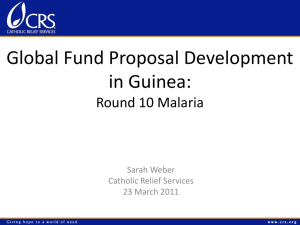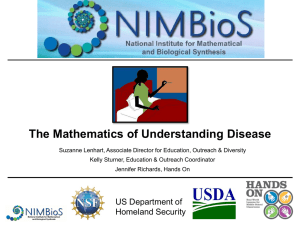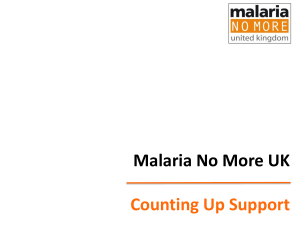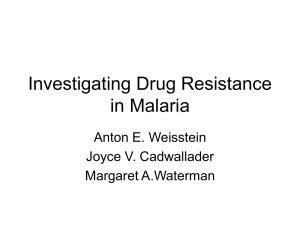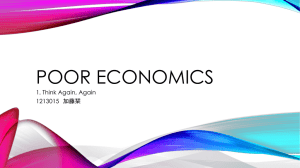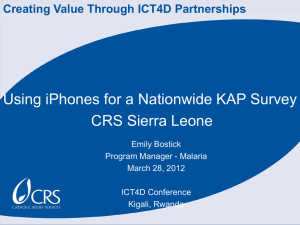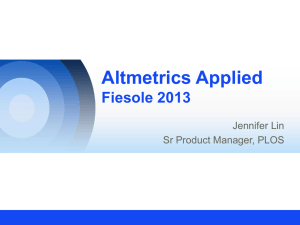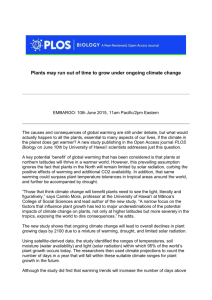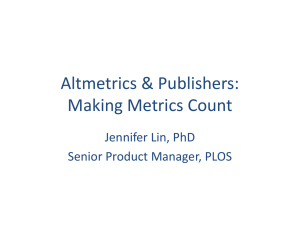PPT slides - BioMed Central
advertisement
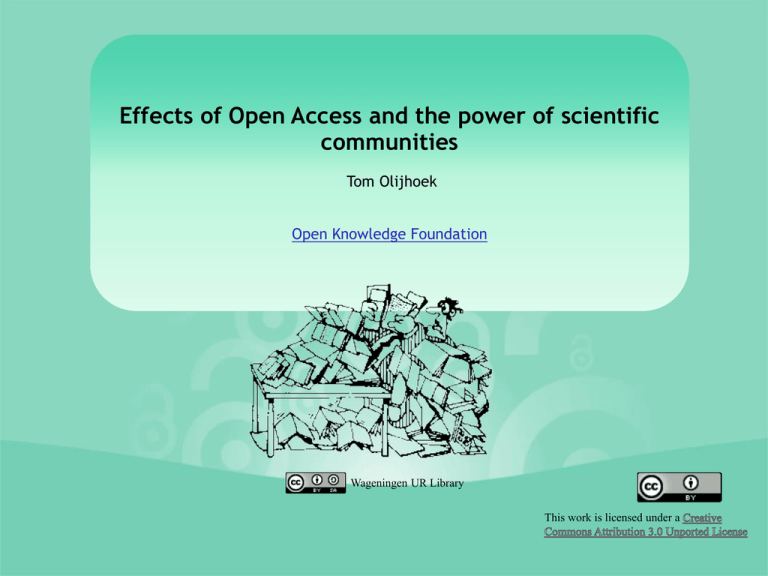
Effects of Open Access and the power of scientific communities Tom Olijhoek Open Knowledge Foundation Wageningen UR Library This work is licensed under a You are free to: Copy, share, adapt, or re-mix; Photograph, film, or broadcast; Blog, live-blog, or post video of; This presentation. Provided that: You attribute the work to its author and respect the rights and licenses associated with its components. Slide Concept by Cameron Neylon, who has waived all copyright and related or neighbouring rights. This slide only ccZero. Social Media Icons adapted with permission from originals by Christopher Ross. Original images are available under GPL at; http://www.thisismyurl.com/free-downloads/15-free-speech-bubble-icons-for-popular-websites Definition and Needs Comparing Open Access and Toll Access publishing The cost of Open Access Effects of Open Access How to get Open Access Tools for use with Open Access Open Access is completely free and unrestricted access to Publications and Data A detailed Definition was published by the Budapest Open Access Initiative in 2001 (BOAI Definition) and an Update was published this year (2012) @ccess, the open access initiative at the Open Knowledge Foundation uses this Definition In addition we strongly recommend using Creative Commons licenses, CC-BY for publications and CC0 for Data whoneedsaccess.org All People NOT only scientists need access to research but can’t get it because of with Open Access 40% of new readers are from outside academia Marcha_por_la_Educación_en_Santiago “more than three-quarters of researchers based in the developing world consider lack of access both to be unethical and costing lives” ( MW Survey) SURVEY RESULTS MALARIAWORLD 95% of respondents agreed or strongly agreed to the ‘statement that Scientific articles on malaria should be available for free to all in need of it’ Only 2% never experience access problems In Africa, South America, and Asia, 41, 79, and 92% of the respondents , respectively, claimed never to use HINARI or did not even know about its existence Testimonials MalariaWorld Research resources for diseases of the poor must be made available without cost to the poor and those who are committed to helping them . Our management discourages us from supporting new open access journals due to their low, or unassigned, impact factor. When did scientists start agreeing with this slave-type of agreement with publishing houses? How could this nonsense have started? We inherited this sick system, but that does not mean we should allow it to continue at my university the department only pay publication fees for persons with a permanent position. The rest of us have to find the money somehow - or bribe a prof Open-source is not without downsides. I favor a mixed model in developed countries with open access for developing countries. TRANSFER of COPYRIGHTS (since 1998!) RIGHT TO READ BUT NOT TO USE PAY PER VIEW 1,350 $ / article 5,333 $ / article 4 x less than Toll Access Eventually cost may go down to 250 $ / article TOTAL 16 billion These are cost for funding agencies On TOTAL Budget 300 billion Open access publishing will then eventually be 20 x cheaper than Toll Access Research funding now needs 5 % for publishing Sources: http://www.stm-assoc.org/2009_10_13_MWC_STM_Report.pdf SVPOW :http://svpow.com/2012/07/18/what-does-it-cost-to-publish-apaywalled-paper-with-anyone/ SOMEHOW SOMEWHERE SOMEONE IS GOING TO PAY WHO PAYS? Less than 1% of current science funding will easily cover the cost of open access publishing Funders and libraries are now paying 5 % or $ 15 billion on a total funding of $ 300 billion IS OPEN ACCESS SUSTAINABLE? Several studies show: OA benefits outweigh the costs by a factor of 5 or more Houghton (2009-2010) Swan (2010) Brembs (2011) CED DCC final Report 2012 The effects of Open Access “ Science & Education Politics Economics Open science Open government development Open education Informed citizens innovation Open Access improves the quality of science OA enables new ways of measuring Impact Open Access improves the quality of science Articles can be reviewed by many Open Science prevents fraud Downloads & social media buzz reflect impact Open data prevents data tampering Include impact in other areas than science Open access enables new forms of collaboration and discovery Michael Nielsen Reinventing Discovery Open access enables citizen science The Impact Factor is a main obstruction to Open Access The current publishing model exploits scientists' addiction to Impact Factor. There is methadone OA, and then there's getting clean. Ethan Perlstein. scientists are hesitant to publish in open access journals because employers are always looking at impact factor Sick of Impact Factors I am sick of impact factors and so is science. The impact factor might have started out as a good idea, but its time has come and gone Stephen Currey How to get rid of the Impact Factor Björn Brembs & Peter Binfield Negotiable Irreproducible Mathematically unsound PLoS Medicine, IF 2-11 (8.4) (The PLoS Medicine Editors (2006) The Impact Factor Game. PLoS Med 3(6): e291. Rossner M, van Epps H, Hill E (2007): Show me the data. The Journal of Cell Biology, Vol. 179, No. 6, 1091-1092 Weak correlation of individual article citation rate with journal IF Björn Brembs http://www.slideshare.net/brembs/limitedaccess-is-a-symptom-not-the-disease ‘New’ Definition of Scientific Impact A-Vector: introducing a new form of journal level metrics Quality of editorial board • • • • Citation index Reputation Collaboration Reference density • More indicators Quality of peer-review • “Transparency” indicators • • • • Criteria used by reviewers Duration of review process Post-publication comments Openness about • • • • submission and Rejection rates potential conflicts of interest Aims, scopes and expected readership Reviewer’s comments and editorial correspondence ( published alongside papers • More indicators A-vector: a new tool for quality Assessment of OA journals Less fraud Less duplication Less important where you publish Open data better control of scientific quality Better use of resources More collaboration All journal content online and accessible Open publications Less bias Crowd control Shorter time between research and practice Reputation not because of selectivity but because of quality OPEN ACCESS TO PUBLICATIONS AND DATA MORE VISIBILITY OF PLAGIARISM FABRICATED DATA PUBLICATION BIAS MORE DIFFICULT TO LEAVE OUT DATA SELECT SPECIFIC RESULTS Pharmaceutical companies “hide” negative results for medicines GSK paid 3 billion fines because of fraud with paxol publications Side effects are often not published High percentage of medical publications are based on flawed experiments RESULT: MANY PEOPLE SUFFER FROM BAD MEDICINES AND EVEN FROM UNNECESSARY TREATMENTS Sources: Howard Brody | Ben Goldacre | Richard Smith | John Ioannidis OA enables higher education for all through the internet • eLearning initiatives like Coursera, eDX, Udacity Level of education will rise rapidly • More education - more economic and social development Open Access opens Science for All Science is the motor for economic development Research is the key to fighting disease Participation of scientists from Africa, Asia and Latin America is necessary for success Open Access crucial for scientists in the global south conference The Hague 25 oct 2012 as long as scientific output remains behind walls of paid content, no possibility for a dialogue will exist How to Get Open Access Scientists hold the power in their own hands Attitude change is crucial Coordination of scientist networked communities Structured information and focused communities “When I light my candle from yours, I gain from you without subtracting from you. That’s what sharing knowledge is like”. Peter Suber Open Access Toll Access getting new ideas by sharing fear of losing ideas Collaboration Competition Publish for impact Publish or perish Focus on quality Focus on quantity The open access movement is fragmented No consensus on what open access is Someone needs to coordinate these communities WHO? No consensus on the best form of open access publishing Need to build communities with common ideas Open Knowledge Foundation?? @ccess OKFN? OpenWetware? We Need to And information it USABLE Datahubs repositories libraries Archives OA journals Social media Scientist networks Indexing services Databases Discussion platforms In order to make optimal use of all possibilities of Open Access Main Task BE A SOURCE OF INFORMATION FOR ALL COMMUNITIES FOCUSSED ON TOPICS African networks like ir-africa.info PatientslikeMe ResearchGate MalariaWorld MyScienceWork Ecancer.org MalariaWorld is a model open access community for malaria research Platform for collaboration POSSIBLE PARTNERS ORGANIZE DATA Open Data archive Publication archive Archive for preprints Tool development Scientific libraries Open access publishers PubmedCentral EU openair Reference managing World Bank UN Discussion, forum, news, jobs, OA Journal BIBSOUP DATA-HUB WIKI ALTMETRICS REPUTATION INDEX A-VECTOR OPEN ACCESS INDEX BibSoup: Malaria Database 2010-2011 used by MalariaWorld Examples of use cc-by 2.5 unknown cc-by 2.0 Graphical representation of types of licences in the malaria database. The largest part is “unknown” Open Access and the role of scientific communities Tom Olijhoek & Mark McGillivray Graphical representation of the 1000 most cited articles in the malaria database. The Header in the figure is the nr 1 citation Malaria Open Access Index developed in collaboration with MalariaWorld HOW OPEN IS MALARIA RESEARCH? J1 Percentage of a articles on malaria in a journal that are Open Access (Y-axis) J2 Percentage of the grand total of OA malaria articles that one journal publishes X-axis) The nine bubbles along the top, from left to right(be careful to note the thin sliver of red that is bubble 6) * BMC Public Health * BMC Inf.Diseases * BMC Genomics * PLoS Medicine * PLoS Pathogens * Parasites and Vectors * PLoS Negl Trop Diseases * PLoS One * Malaria Journal And finally the small one on the bottom left: * Virology Journal Open Access and the role of scientific communities Tom Olijhoek & Mark McGillivray PLoSOne (brown) and Malaria Journal (blue) have highest index OpenWetWare is an effort to promote the sharing of information, know-how, and wisdom among researchers and groups who are working in biology & biological engineering Open Source Drug Discovery (OSDD) is the concept of drug discovery where all data and ideas are shared in real time, and anyone may participate at any level. This prior disclosure means that will be no patents and that any technology is both academically and commercially exploitable by whoever wishes to do so. Pilot research communities focus on tropical diseases: Open Source Biomedical Research for the 21st Century An open, collaborative research community will find new ways to do science, answering questions that current institutions find difficult or impossible. / Diseases found exclusively in tropical regions predominantly afflict poor people in developing countries. The typical profit-driven pharmaceutical economic model fails with these diseases …………
